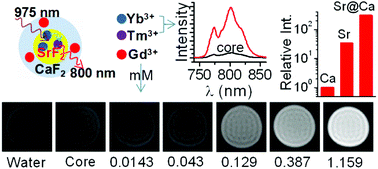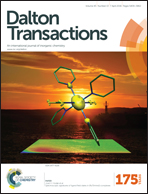Upconversion-luminescent/magnetic dual-functional sub-20 nm core–shell SrF2:Yb,Tm@CaF2:Gd heteronanoparticles†
Abstract
Sub-20 nm core–shell and water-soluble SrF2:Yb,Tm@CaF2:Gd heteronanoparticles with both upconversion luminescence (UCL) and magnetic resonance imaging (MRI) capabilities were designed and synthesized via a two-step hydrothermal method. In the design of the heteronanoparticles, SrF2:Yb,Tm nanoparticles with high UCL efficiency are chosen as the core material for strong UCL output; and by epitaxially coating the SrF2:Yb,Tm core particles with inert and biocompatible shells of CaF2:Gd, the core–shell heteronanoparticles are endowed with a magnetic capability (longitudinal relaxivity of 2.4 mM−1 s−1) for MRI, as well as an enhancement of the near infrared (NIR) UCL by 9.2 times. The aqueous dispersion of SrF2:Yb,Tm@CaF2:Gd heteronanoparticles with a concentration of 2.6 wt% can emit NIR UCL so as to be easily detected with a fiber optical spectrometer under illumination of a 975 nm laser diode with a power density of 8.8 W cm−2. Such a dispersion with a Gd3+ concentration of 0.0143 mM in the shell region of the heteronanoparticles can also generate the detectable quickening of longitudinal relaxation. The results promise the strong potential of this nanomaterial for applications in bioimaging as a dual-functional probe.


 Please wait while we load your content...
Please wait while we load your content...